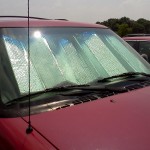It’s So Hot, You Could Almost…
It’s so hot, you could almost fry an egg on the sidewalk. From magenta to tangerine, National Weather Service maps are lit up with colors straight out of a box of Crayola crayons. While it’s a pleasant sight for those of us sitting in the air conditioning, these brilliant hues stand for the Excessive Heat Warnings and Heat Advisories that are issued for most of Pennsylvania. Temperatures range from the mid-90s to near 100-degrees. Heat indexes are climbing even higher.
Curious (well-hydrated and wearing light colored clothing), Radio PA’s Brad Christman and Matt Paul headed outside in an attempt to “literally” fry an egg on the sidewalk. Around 3:30pm on Thursday, with the air temperature in Harrisburg near 99-degrees… the project was unsuccessful (note the picture above).
On a serious note, an Excessive Heat Warning means that a prolonged period of dangerously hot temperatures will occur. According to the National Weather Service, the combination of hot temperatures and high humidity combine to create a dangerous situation.
These conditions make everybody vulnerable to heat-related illnesses, like heat stroke. “When this happens, body temperatures can rise to excessive levels, 107, 108, 109-degrees. When that happens it essentially causes a breakdown of critical functions of the body,” says Dr. John Skiendzielewski, director of emergency medicine at Geisinger Medical Center.
Dr. Skiendzielewski cautions that senior citizens are especially susceptible. “Because of problems with their circulation… and prior strokes, they just can’t handle that as well as younger individuals can.” He urges everyone to check on elderly loved ones or neighbors in these conditions. “The elderly, unfortunately during these economic times, also try to conserve money. So, they won’t turn on their air conditioners even if they have it,” Dr. Skiendzielewski cautions. If seniors are having problems, take them some place cooler.




